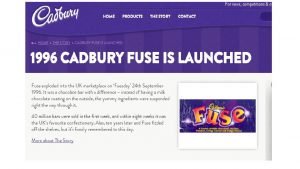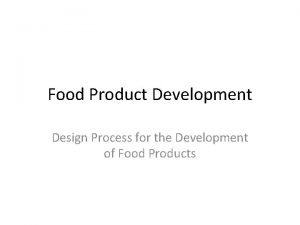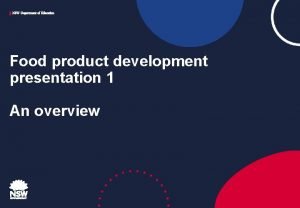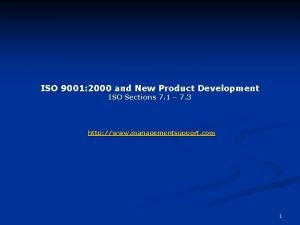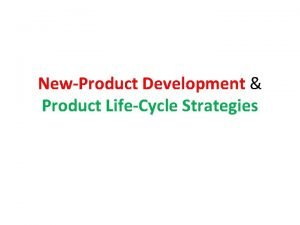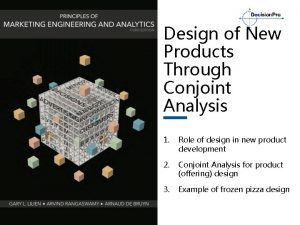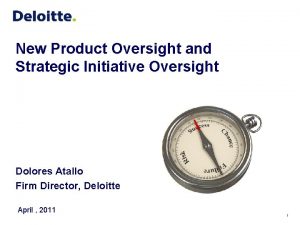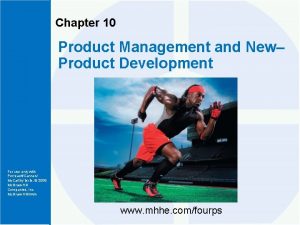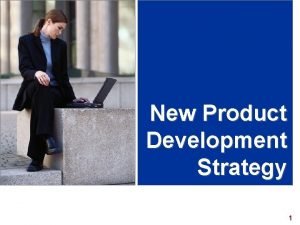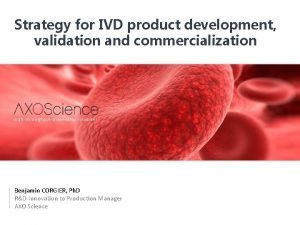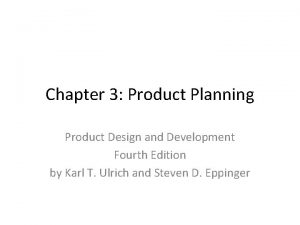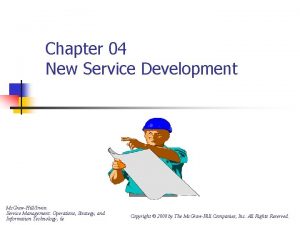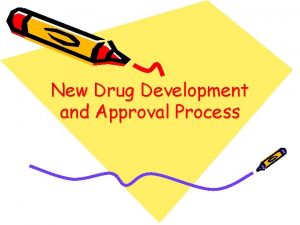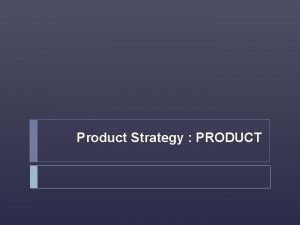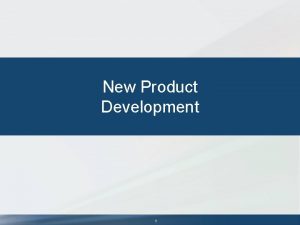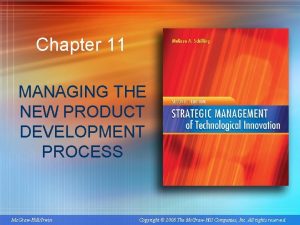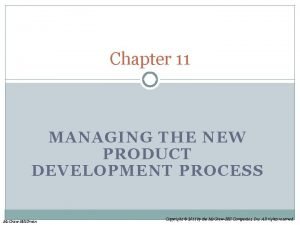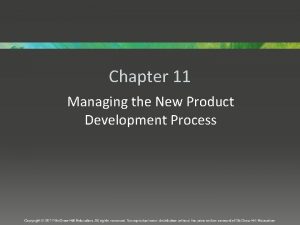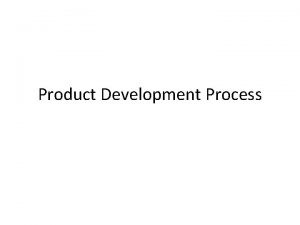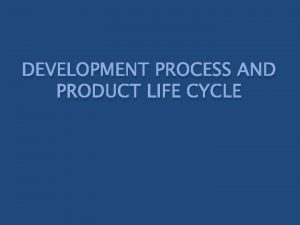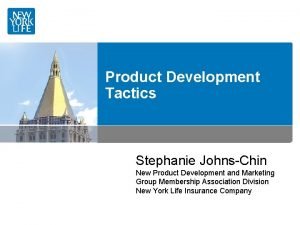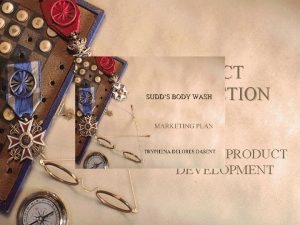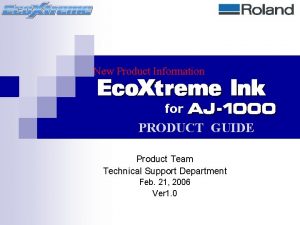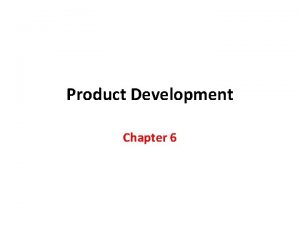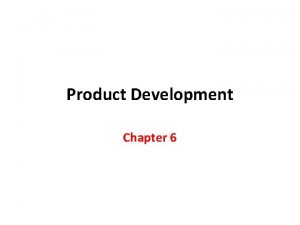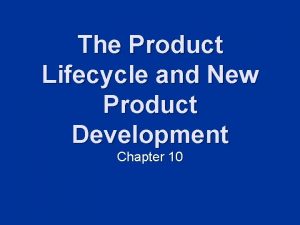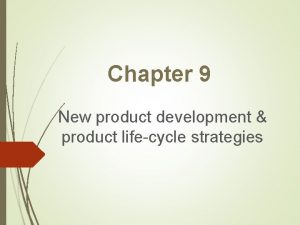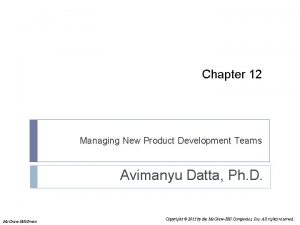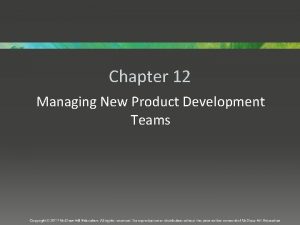Chapter 11 Managing the New Product Development Process
























- Slides: 24

Chapter 11 Managing the New Product Development Process Copyright © 2013 by Prof. D. J. Lee, Kyung Hee University All rights reserved.

Overview • Despite the intense attention paid to innovation, failure rates are still very high. • More than 95% of new product development projects fail to earn an economic return. • This chapter summarizes research on how to make new product development more effective and efficient. 11 -2

Objectives of the New Product Development Process • Maximizing fit with customer requirements • requires knowing which features are most important to customers, what a customer is willing to pay, and how to resolve competing customer desires. § Technologically advanced - Highly advanced chip - Object oriented OS - Openly licensed the architecture - Better weight, size, battery life § However, - Too large to kept in a pocket - Too small screen - Problems with handwriting recognition Apple’s Newton Message. Pad 11 -3

Objectives of the New Product Development Process • Minimizing development cycle time • can afford a firm the opportunity to be first to market with a new product (i. e. better opportunity to build brand loyalty, capture scarce assets, build customer switching costs, and develop complementary goods). • Development costs are directly related to time • High chance to fully amortize the fixed initial cost of NPD before obsolete (critical when short life cycle) • Can quickly revise or upgrade design flaws • Controlling development costs • important because even if products are a good fit with customer requirements and are brought to market quickly, if development costs are uncontrolled the firm will have a difficult time recouping its expenses. 11 -4

Sequential versus Partly Parallel Development Processes • Sequential NPD process: working this way often resulted in multiple product revisions and lengthy cycle times. • Partly parallel process (Concurrent Eng. ): shortening overall cycle and enabling developers to communicate requirements in the next phase. 11 -5

Sequential versus Party Parallel Development Processes • Parallel processes are not universally endorsed • If variants in product design require significant changes to the process design, beginning process design before the end of product design can result in costly rework of the production process • Highly risky especially in markets with rapid change and uncertainty 11 -6

Project Champions • As of 2001, 68% of North American firms, 58% of European firms, and 48% of Japanese firms reported using senior executives to champion their NPD projects. • Benefits of Championing • Senior execs have power to fight for project • They can gain access to resources • They can communicate with multiple areas of firm • Risks of Championing • Role as champion may cloud judgment about project • May suffer from escalating commitment • Others may fear challenging senior executive • To counteract these risks, firms may create the role of “anti-champion” and encourage expression of dissenting opinion. 11 -7

Theory In Action The Development of Zantac • In the 1970 s, David Jack of Glaxo Holdings began working on an ulcer drug. Unfortunately, Smith. Kline Beecham beat Glaxo to market, introducing Tagamet in 1977. • Jack decided to introduce an improved product, and implemented the first parallel process in pharmaceuticals to beat Merck and Eli Lilly to market. The compressed development process would shorten development time, but was also expensive and risky. • Fortunately, Paul Girolami, Glaxo’s director of finance, chose to champion the project, and encouraged Jack to develop improvements to the product which would differentiate it. • By 1987, Glaxo’s Zantac was outselling Tagamet. Jack and Girolami were knighted, and Girolami became Glaxo’s chairman. 11 -8

Involving Customers and Suppliers in the Development Process • Involving Customers • Customer is often best able to identify the maximum performance capabilities and minimum service requirements of new product. • Customers may be involved on NPD team. • Firms may also use beta testing to get customer input early in the development process. • Enabling customers to “cocreate” the end product 11 -9

Involving Customers and Suppliers in the Development Process • Involving Customers • Some studies suggest that it is more valuable to use “lead users” than a random sample of customers. • Lead users: Customers who face the same general needs of marketplace but experience them earlier than rest of market and benefit disproportionately from solutions. • In 2003, firms reported using lead user method for 38% of the projects they undertook, on average. • Involving Suppliers • Involving suppliers on NPD team or consulting as an alliance partner can improve product design and development efficiency. • Suppliers can suggest alternative inputs that reduce cost or improve functionality. • Ex) Chrysler’s SCORE, Boeing’s development of 777 11 -10

Research Brief • • • The Lead User Method of Product Concept Development Hilti AG used the lead user method to develop a new pipe hanger. First customers with lead user characteristics were identified through phone interviews. Lead users participated in a three-day product concept generation workshop. At end of workshop, a single design was selected as best. Hilti then presented this design to 12 long-term customers; 10 of the 12 preferred the new design and 9 of the 10 were willing to pay a 20% price premium for it. The lead user method reduced the cost and time of the project by almost half. 11 -11

Tools for Improving the NPD Process(Stage-Gate) • Stage-Gate Processes • Utilize tough go/kill decision points in the development process help filter out bad projects. 11 -12

Tools for Improving the NPD Process(Stage-Gate) • Each gate has three components • Deliverables • Criteria • outputs • The time and cost of projects escalates with each stage, thus stage-gate processes only permit a project to proceed if all assessments indicate success. 11 -13

Tools for Improving the NPD Process(Stage-Gate) • The stage-gate process can be modified to better fit a firm’s particular development needs. • E. g. , Exxon Research and Engineering’s stage-gate system • Nearly 60% of firms use some type of stage-gate process to manage their NPD process. 11 -14



Tools for Improving the NPD Process(QFD) • QFD improves communication and coordination between engineering, marketing, and manufacturing. 11 -17

Tools for Improving the NPD Process(QFD) • Steps for QFD 1. 2. 3. 4. 5. 6. 7. 8. 9. Team identifies customer requirements. Team weights requirements in terms of relative importance. Team identifies engineering attributes that drive performance. Team enters correlations between different engineering attributes. Team indicates relationship between engineering attributes and customer requirements. Team multiplies customer importance rating by relationship to engineering attribute and then sums for each attribute. Team evaluates competition. Using relative importance ratings for engineering attributes and scores for competing products, team determines design targets. Team evaluates the new design based on the design targets. 11 -18

Tools for Improving the NPD Process(DFM) • Design for Manufacturing often involves a set of design rules that reduce cost and development time, while boosting quality. 11 -19

Tools for Improving the NPD Process(FMEA) • FMEA(Failure Modes and Effects Analysis) is a method by which firms identify potential failures in a system, classify them according to their severity, and create a plan to prevent them. • Potential failure modes are evaluated on three criteria of risk: severity, likelihood, and inability of controls to detect the failure. • Each criteria is given a score (1 -lowest, 5 -highest) • Composite score is used to prioritize development efforts 11 -20

Tools for Improving the NPD Process(CAD/CAM) • Computer-Aided Design (CAD) is the use of computers to build and test designs. • Enables rapid and inexpensive prototyping. • Computer-Aided Manufacturing (CAM) is the use of machine-controlled processes in manufacturing. • Increases flexibility by enabling faster changes in production set ups. More product variations can be offered at a reasonable cost. 11 -21

Tools for Measuring New Product Development Performance • Measuring performance of NPD process can help company improve its innovation strategy and process. • Measures of NPD performance can help management: • identify which projects met their goals and why, • benchmark the organization’s performance compared to that of competitors, or to the organization’s own prior performance, • improve resource allocation and employee compensation, and • refine future innovation strategies • Important to use multiple measures to provide fair representation 11 -22

Tools for Measuring New Product Development Performance • New Product Development Process Metrics include: 1. What was the average cycle time (time-to-market) for development projects? How did this cycle time vary for projects characterized as breakthrough, platform, or derivative projects? 2. What percentage of development projects undertaken within the last five years met all or most of the deadlines set for the project? 3. What percentage of development projects undertaken within the last five years stayed within budget? 4. What percentage of development projects undertaken within the last five years resulted in a completed product? 11 -23

Tools for Measuring New Product Development Performance • Overall Innovation Performance measures include: 1. What is the firm’s return on innovation? (This measure assesses the ratio of the firm’s total profits from new products to its total expeditures, including research and development costs, the costs of retooling and staffing production facilities, and initial commercialization and marketing costs. ) 2. What is the percentage of projects that achieve their sales goals? 3. What percentage of revenues are generated by products developed within the last five years? 4. What is the firm’s ratio of successful projects to its total project portfolio? 11 -24
 New product development and product life cycle strategies
New product development and product life cycle strategies Idea development process
Idea development process Food product design
Food product design Product planning and development definition
Product planning and development definition Idea generation contoh
Idea generation contoh Humi seal
Humi seal Tabular wbs
Tabular wbs New product development presentation
New product development presentation New product development procedure iso
New product development procedure iso Embedded development life cycle
Embedded development life cycle Product planning and development
Product planning and development Strategic management
Strategic management Conjoint analysis
Conjoint analysis What is the ipde process
What is the ipde process Ipde process definition
Ipde process definition Ipde process definition
Ipde process definition Use the ipde process chapter 5
Use the ipde process chapter 5 Orderly visual search pattern
Orderly visual search pattern New product approval process
New product approval process New product planning process
New product planning process New product introduction process
New product introduction process Ivd product development
Ivd product development Chapter 3 designing and planning
Chapter 3 designing and planning New service concept design
New service concept design Abbreviated new drug application
Abbreviated new drug application

